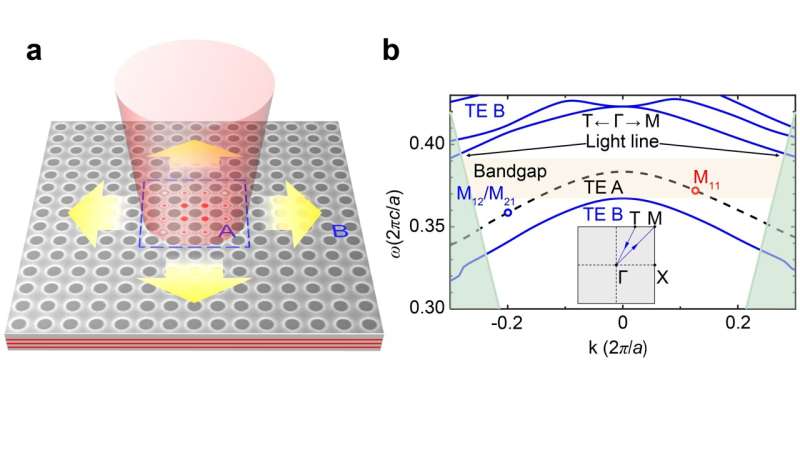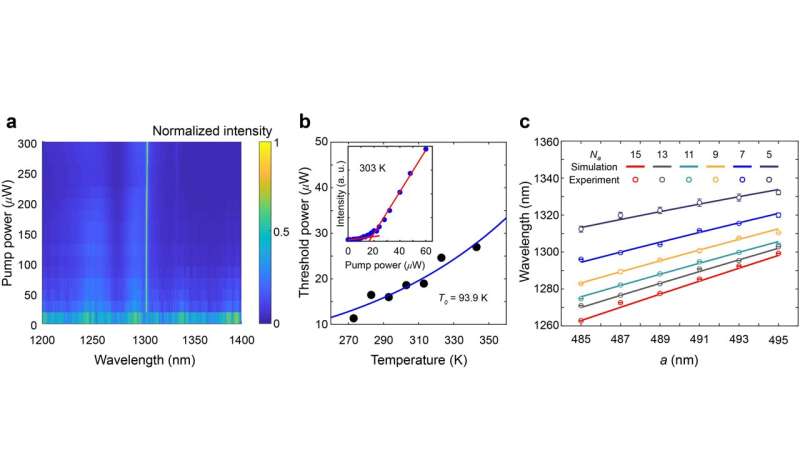This article has been reviewed according to Science X's editorial process and policies. Editors have highlighted the following attributes while ensuring the content's credibility:
fact-checked
peer-reviewed publication
trusted source
proofread
Study presents ultra-low threshold continuous-wave quantum dot mini-BIC lasers

Lasers with ultra-low threshold and compact size are highly desirable components in photonic integrated circuits, aiming at the application of optical communications, chip-scale solid-state LIDAR and quantum information. The general approach to realizing such lasers is to effectively trap light and boost light-matter interaction by embedding gain materials into few- or sub-wavelength scale optical cavities with high quality (Q) factor and/or small mode volume (V-mode).
Low-threshold lasing has been realized on planar photonic crystal via introducing defect-type PhC modes or photonic bound states in the continuum (BICs) modes. For lasing action, the reported defect-type PhC lasers, while exhibiting extremely small V-mode and therefore ultra-low threshold, nevertheless suffers instability caused by sensitivity to the structural disorder.
In this regard, BIC lasers that may benefit from topological robustness are one of the most promising alternative architectures. However, radiative BIC (quasi-BIC) modes in PhC slabs or gratings with high Q-factor are often realized requiring extended lateral periodic structures to reduce in-plane light leakage, therefore intrinsically limiting their footprint to hundreds of unit-cells. In addition, BICs can only confine light in vertical direction, making its threshold difficult to further reduce.
A research group involving Ying Yu and Siyuan Yu from Sun Yat-sen University presents the realization of CW operated BIC lasers with low-thresholds and small V-modes by combining O-band InAs/GaAs epitaxial QD gain material with mini-BIC cavities. Benefitting from the three-dimensional confinement of both light and carriers provided by the mini-BIC cavity and the QD, the ultra-low threshold of below 20 μW and small size of ~2.5×2.5 μm2 are achieved. The study is published in the journal Light: Science & Applications.

Different from the traditional BIC, mini-BIC not only confines light in the vertical direction, but also traps light in the transverse direction by the photonic bandgap of the lateral hetero-structure. Therefore, it has no requirement for long-range periodicity and thus allows for smaller structural size. Mini-BIC structure consists of two sets of photonic crystals with different periods, A and B, as shown in Fig. 1a. Cavity A serves as a resonant microcavity for lasers.
Since it is a finite photonic crystal, its mode exists as discrete state Mpq in k-space (where p and q are positive integers, such as M11). By designing the state Mpq of A to be exactly in the bandgap of B, light can be laterally trapped. As shown in Fig. 1b, M11 and M12/M21 are resonant states in the continuum above the light cone. To further enhancing vertical light confinement, the discrete state could be designed to converge with accidental BIC modes in k-space, by fine-tuning the lattice constant of region A and the hole radius. The Q factor of preferred lasing mode could be also further improved.
Experimentally, the researchers first fabricate mini-BIC structure on InAs/GaAs QD active membrane with micromachining, and then transfer the active membrane to the glass substrate. Finally, the surface of membrane was covered with a layer of glass using an ultraviolet curing adhesive, to ensure the mirror-flip symmetry of PhC slab. By design, continuous-wave, single mode lasing is achieved with the cavity size down to 5×5 unit-cells (~2.5×2.5 μm2 with a mode volume of 1.16(λ/n)3).
As shown in Fig. 2a, the device exhibits an ultra-low single mode lasing threshold of 17 μW (0.074 kW cm-2). Further temperature dependent laser performance test shows that the maximum operating temperature can reach 343 K (70 ℃), and the characteristic temperature is fitted as 93.9 K, as shown in Fig. 2b. By careful engineering of structural parameters, the mini-BIC lasers have also been tuned across a wavelength range of 80 nm (Fig. 2c).
In summary, the researchers demonstrate a structure that enabling effective trapping of both light and carriers in all three dimensions, by fabricating a miniaturized BIC cavity in an epitaxial QD gain membrane. They successfully achieve efficient, high spectral quality, precisely wavelength engineered miniature laser in the 1,310 nm O-band wavelength range. The mini-BIC lasers, fabricated by membrane transfer technique, can be flexibly implemented on different substrate such as silicon or LiNbO3.
With its advantages in terms of a small footprint, ultralow threshold and adaptability for integration, precisely wavelength engineering, the mini-BIC lasers offer a perspective light source for future PICs aimed at high-capacity optical communications, sensing and quantum information.
More information: Hancheng Zhong et al, Ultra-low threshold continuous-wave quantum dot mini-BIC lasers, Light: Science & Applications (2023). DOI: 10.1038/s41377-023-01130-5
Journal information: Light: Science & Applications
Provided by Chinese Academy of Sciences




















